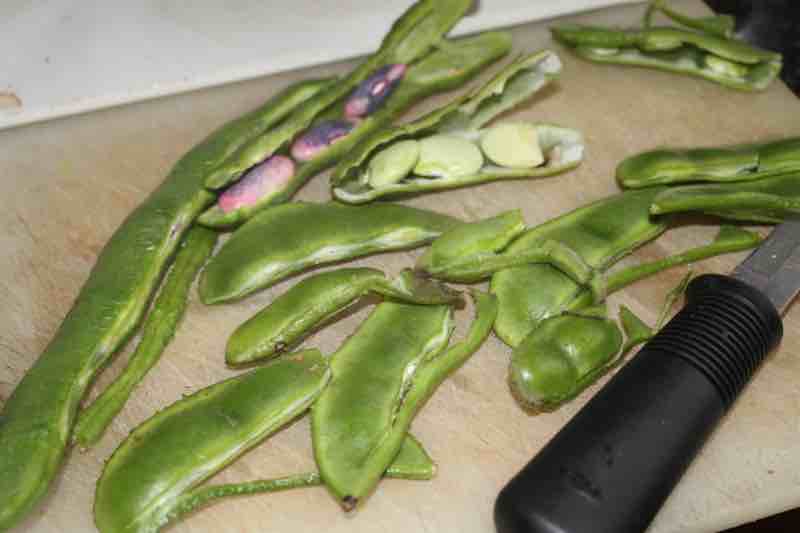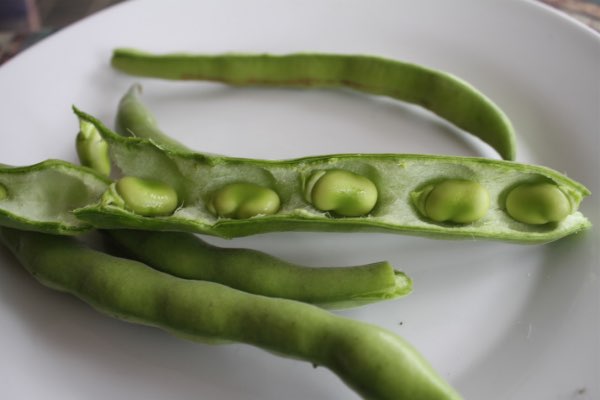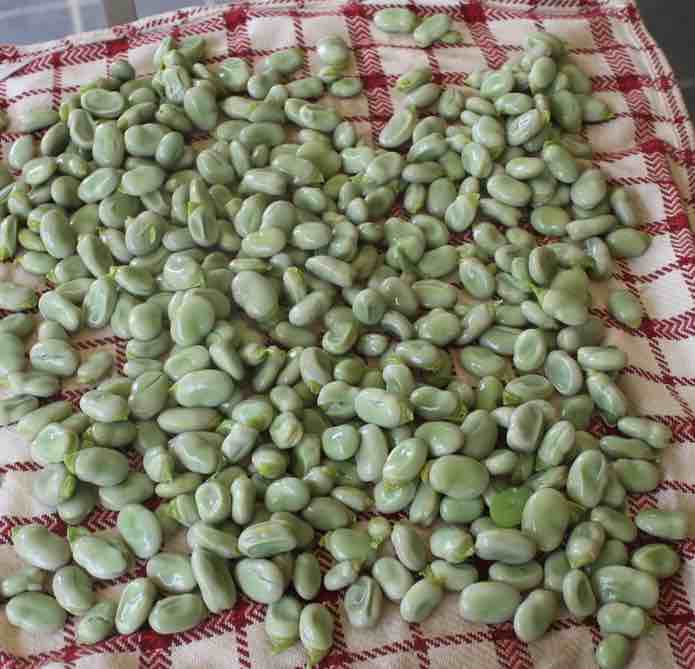- Bernard Preston homepage
- Legumes
- Shelling Large Green Beans
Shelling large green beans
Shelling large green beans may put many people off, making them select canned-varieties instead; but there is a way to do it quickly and efficiently.
We are very fortunate here in the Midlands of South Africa that we can enjoy green legumes all year-round. Favas and peas are our favourites in the winter; pole beans, limas and scarlet runners in the summer. And a host of others of course but those are the ones that keep us in lovely vegetable protein.
The new buzzword in mainline healthcare is using food as medicine. Even type-2 diabetes can be brought completely into remission without the use of drugs.
See what else is potting in the summer vegetable garden.
We are not vegetarians but are trying to lessen our reliance on red meat as the whole planet will have to do in the next few decades anyway; if we want to survive the ravages of greenhouse gases. Fresh from the garden we love our peas and beans. Cooked imaginatively with herbs and spices they are absolutely delicious.
I'm less enthusiastic about dried and canned beans.
There are several good reasons to enjoy green legumes. To begin with they are a lot nicer than dried beans and peas; easier and quicker to prepare also, even if you have a pressure-cooker.
 Look closely to see how these beans have been strung prior to podding.
Look closely to see how these beans have been strung prior to podding.The second is that green beans and peas have far less of substances being called antinutrients. These are produced by plants to protect themselves from pests, one of which is a mammal known as the human being. In particular, "trypsin inhibitors" slow the digestion and absorption of protein by countering some of the pancreatic enzymes.
Others like phytates reduce the absorption of minerals from our food.
What actually are legumes you may be asking.
The antinutrient content of soy beans is about ten times greater than the other more common legumes which is why many people don’t like them in burgers; they are very indigestible and leave one with discomfort in the belly. Fermented as the Chinese do is quite different.
Peas have by far the least antinutrients; 2% of those in soy beans. That is why we can enjoy them raw without abdominal pain. All other legumes should be cooked.
The influence of these antinutrients is greatly reduced by soaking, rinsing and cooking; and using salt when boiling or roasting. Such that a person enjoying well-rounded meals need have no qualms about them whatsoever; at least that's my opinion.
The downside of the larger green beans and peas is that shelling takes a lot of time; and is particularly hard on the thumbnails. And so many people, to their detriment shun them in favour of dried legumes; or from a can.
We have tried various different ways of shelling beans and eventually I have come to the conclusion that it is best to cut away a thin slice along the side where the seed attaches with a sharp knife. Then they pop out much more easily.
It is one of the reasons why the common green-bean is favoured by everyone; it doesn't need podding.
Young broad beans can be cooked and eaten in their jackets too; in fact there is even more of a very important phytochemical called L-dopa in the pod[3].
Like all vegetables freshly picked fava beans and peas are far sweeter than those that are days old or from a can. Late summer is the season to plant them in mild climates but spring was when we set the seeds out in Chicago. They take at least two-months before you can reap the fruit, and often longer but then they go on bearing for ages.
It’s amazing how much money you can save by growing your own vegetables.
And how much nicer they are when freshly-picked and cooked. They are more nutritious too I suspect.
 Enjoy young broad beans in their jackets.
Enjoy young broad beans in their jackets.Picking your large green beans and other vegetables, from the garden is time-consuming, especially the limas that hide in the foliage. Instead of getting frustrated we have turned our minds around to think of it as forest bathing; a period of peace and quiet where you might meet with God and may even see some fairies.
They are a wonderful source of protein; one cup of cooked lima beans, for example will supply you with nearly a third of the amino-acids needed for the day. They are often served in traditional American culture with corn in a dish called succotash. Both have a high fibre content so the net carbs[2] are low.
Those on the typical "industrial diet" get less than half of the fibre they need; constipation, serious bowel diseases and depleted microbiomes are the order of the day.
What is a dietary fiber is a question we should all be able to answer; it's that important.
I now look at every recipe with the time taken to prepare it in mind. Does succotash have any advantage over corn on the cob and a plate of lima-beans? I don't think so.
Green beans are a very good source of a phytonutrient called betaine; it has an extremely important role to play in preventing inflammation in the body.
Starch
Legumes have come in for a lot of stick because of their starch content. Those on a very low carb meal plan are encouraged to eschew peas and even green beans; wrongly so in my opinion.
Then the schlep of shelling large green beans may be just one more reason not to grow or purchase them.
Avoid them at your peril in my opinion, except perhaps for a season if you are very obese; and must reduce your daily carbohydrate below 30g per day for a few months while you get all those pounds off.
Do remember that many diets more than double the risk of heart attack or stroke[4]. They don't work anyway; we recommend banishing that dirty four-letter word permanently from your thinking.
It makes a lot of sense for the obese to limit all starches but for a season only. So some of the ketogenic diets are helpful but we think them unsustainable; then they are doomed to fail. Can you give up bread for ever? And should you for that matter?
Instead could you not apply your mind and learn about the meaning of sourdough?
Half a cup of lima beans has 20g of starch but a third of that is fibre that does not produce glucose; it passes through to the colon where it is digested by the normal flora forming highly beneficial short-chain fatty acids instead.
So the net carbs[2] are only about 13g.
There is oodles of research showing that diabetics on high-fibre meal plans have far better glucose and insulin profiles; with lower cholesterol and triglycerides too. Enjoying green beans is using food as medicine.

Every person with a tremor needs to know how to plant broad beans; they are the only natural source of dopamine. Here we are drying them after blanching; having a whole year's supply in the deep freeze. They make you feel good too.
When shelling large green beans like favas we just give the pod a twist instead of stringing; it's marginally quicker.
"There is increasing evidence that exposure to plants and green space and particularly to gardening, is beneficial to mental and physical health."
- Clinical Medicine (PMC6334070)
Shelling large green beans
Shelling large green beans is time-consuming but there are ways of doing it neatly with a sharp knife.
At the end of the day it is about one's philosophy of life. We prefer to spend time in the garden and shelling large green beans than consulting doctors and taking medication; each to their own.
When browsing use right click and Open Link in New Tab, or you may get a bad gateway signal.
Newsletter
Our newsletter is entitled "create a cyan zone" at your home, preserving both yourself and Mother Earth for future generations; and the family too, of course. We promise not to spam you with daily emails promoting various products. You may get an occasional nudge to buy one of my books.
Here are the back issues.
- Lifestyle and ideal body weight
- What are ultra-processed foods?
- Investing in long-term health
- Diseases from plastic exposure
- Intensive lifestyle management for obesity has limited value
- A world largely devoid of Parkinson's Disease
- The impact of friendly bacteria in the tum on the prevention of cancer
- There's a hole in the bucket
- Everyone is talking about weight loss drugs
- Pull the sweet tooth
- If you suffer from heartburn plant a susu
- Refined maize meal and stunting
- Should agriculture and industry get priority for water and electricity?
- Nature is calling
- Mill your own flour
- Bake your own sourdough bread
- Microplastics from our water
- Alternative types of water storage
- Wear your clothes out
- Comfort foods
- Create a bee-friendly environment
- Go to bed slightly hungry
- Keep bees
- Blue zone folk are religious
- Reduce plastic waste
- Family is important
- What can go in compost?
- Grow broad beans for longevity
- Harvest and store sunshine
- Blue zone exercise
- Harvest and store your rainwater
- Create a cyan zone at your home
Did you find this page interesting? How about forwarding it to a friendly book or food junkie? Better still, a social media tick would help.
- Bernard Preston homepage
- Legumes
- Shelling Large Green Beans
Address:
56 Groenekloof Rd,
Hilton, KZN
South Africa
Website:
https://www.bernard-preston.com